
- Bioactive Compounds
- By Signaling Pathways
- PI3K/Akt/mTOR
- Epigenetics
- Methylation
- Immunology & Inflammation
- Protein Tyrosine Kinase
- Angiogenesis
- Apoptosis
- Autophagy
- ER stress & UPR
- JAK/STAT
- MAPK
- Cytoskeletal Signaling
- Cell Cycle
- TGF-beta/Smad
- DNA Damage/DNA Repair
- Compound Libraries
- Popular Compound Libraries
- Customize Library
- Clinical and FDA-approved Related
- Bioactive Compound Libraries
- Inhibitor Related
- Natural Product Related
- Metabolism Related
- Cell Death Related
- By Signaling Pathway
- By Disease
- Anti-infection and Antiviral Related
- Neuronal and Immunology Related
- Fragment and Covalent Related
- FDA-approved Drug Library
- FDA-approved & Passed Phase I Drug Library
- Preclinical/Clinical Compound Library
- Bioactive Compound Library-I
- Bioactive Compound Library-Ⅱ
- Kinase Inhibitor Library
- Express-Pick Library
- Natural Product Library
- Human Endogenous Metabolite Compound Library
- Alkaloid Compound LibraryNew
- Angiogenesis Related compound Library
- Anti-Aging Compound Library
- Anti-alzheimer Disease Compound Library
- Antibiotics compound Library
- Anti-cancer Compound Library
- Anti-cancer Compound Library-Ⅱ
- Anti-cancer Metabolism Compound Library
- Anti-Cardiovascular Disease Compound Library
- Anti-diabetic Compound Library
- Anti-infection Compound Library
- Antioxidant Compound Library
- Anti-parasitic Compound Library
- Antiviral Compound Library
- Apoptosis Compound Library
- Autophagy Compound Library
- Calcium Channel Blocker LibraryNew
- Cambridge Cancer Compound Library
- Carbohydrate Metabolism Compound LibraryNew
- Cell Cycle compound library
- CNS-Penetrant Compound Library
- Covalent Inhibitor Library
- Cytokine Inhibitor LibraryNew
- Cytoskeletal Signaling Pathway Compound Library
- DNA Damage/DNA Repair compound Library
- Drug-like Compound Library
- Endoplasmic Reticulum Stress Compound Library
- Epigenetics Compound Library
- Exosome Secretion Related Compound LibraryNew
- FDA-approved Anticancer Drug LibraryNew
- Ferroptosis Compound Library
- Flavonoid Compound Library
- Fragment Library
- Glutamine Metabolism Compound Library
- Glycolysis Compound Library
- GPCR Compound Library
- Gut Microbial Metabolite Library
- HIF-1 Signaling Pathway Compound Library
- Highly Selective Inhibitor Library
- Histone modification compound library
- HTS Library for Drug Discovery
- Human Hormone Related Compound LibraryNew
- Human Transcription Factor Compound LibraryNew
- Immunology/Inflammation Compound Library
- Inhibitor Library
- Ion Channel Ligand Library
- JAK/STAT compound library
- Lipid Metabolism Compound LibraryNew
- Macrocyclic Compound Library
- MAPK Inhibitor Library
- Medicine Food Homology Compound Library
- Metabolism Compound Library
- Methylation Compound Library
- Mouse Metabolite Compound LibraryNew
- Natural Organic Compound Library
- Neuronal Signaling Compound Library
- NF-κB Signaling Compound Library
- Nucleoside Analogue Library
- Obesity Compound Library
- Oxidative Stress Compound LibraryNew
- Plant Extract Library
- Phenotypic Screening Library
- PI3K/Akt Inhibitor Library
- Protease Inhibitor Library
- Protein-protein Interaction Inhibitor Library
- Pyroptosis Compound Library
- Small Molecule Immuno-Oncology Compound Library
- Mitochondria-Targeted Compound LibraryNew
- Stem Cell Differentiation Compound LibraryNew
- Stem Cell Signaling Compound Library
- Natural Phenol Compound LibraryNew
- Natural Terpenoid Compound LibraryNew
- TGF-beta/Smad compound library
- Traditional Chinese Medicine Library
- Tyrosine Kinase Inhibitor Library
- Ubiquitination Compound Library
-
Cherry Picking
You can personalize your library with chemicals from within Selleck's inventory. Build the right library for your research endeavors by choosing from compounds in all of our available libraries.
Please contact us at info@selleckchem.com to customize your library.
You could select:
- Antibodies
- Bioreagents
- qPCR
- 2x SYBR Green qPCR Master Mix
- 2x SYBR Green qPCR Master Mix(Low ROX)
- 2x SYBR Green qPCR Master Mix(High ROX)
- Protein Assay
- Protein A/G Magnetic Beads for IP
- Anti-Flag magnetic beads
- Anti-Flag Affinity Gel
- Anti-Myc magnetic beads
- Anti-HA magnetic beads
- Poly DYKDDDDK Tag Peptide lyophilized powder
- Protease Inhibitor Cocktail
- Protease Inhibitor Cocktail (EDTA-Free, 100X in DMSO)
- Phosphatase Inhibitor Cocktail (2 Tubes, 100X)
- Cell Biology
- Cell Counting Kit-8 (CCK-8)
- Animal Experiment
- Mouse Direct PCR Kit (For Genotyping)
- New Products
- Contact Us
research use only
Rapamycin (Sirolimus) mTOR inhibitor
Rapamycin is a specific mTOR inhibitor with IC50 of ~0.1 nM in HEK293 cells. This compound binds to FKBP12 and specifically acts as an allosteric inhibitor of mTORC1. It is an autophagy activator and an immunosuppressant.
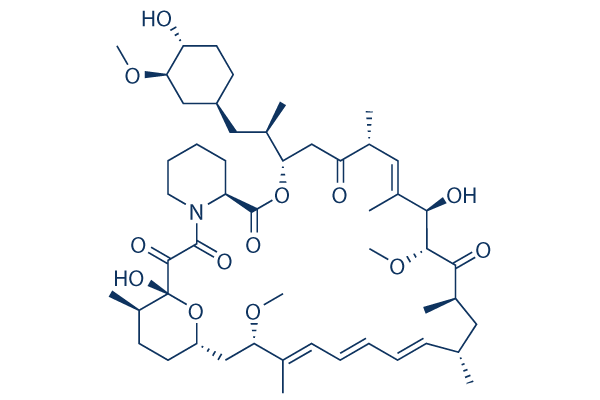
Chemical Structure
Molecular Weight: 914.18
Purity & Quality Control
Batch:
Purity:
99.63%
99.63
Products Often Used Together with Rapamycin (Sirolimus)
IKE (Imidazole Ketone Erastin)
It and Imidazole ketone erastin induce cell death in ALL cell lines, resulting in a longer survival time for xenograft mice with ALL.
This compound and MG132 combination synergize the apoptotic and autophagic effects of curcumol in nasopharyngeal carcinoma.
Combined use of this compound reduces photoreceptor necrosis and preserve the ONL thickness after retinal detachment.
Related Products
| Related Targets | mTORC1 mTORC2 | Click to Expand |
|---|---|---|
| Related Products | AZD8055 Torin 1 Ridaforolimus (Deforolimus, MK-8669) Sapanisertib (MLN0128) Torkinib (PP242) Vistusertib (AZD2014) MHY1485 KU-0063794 Torin 2 OSI-027 WYE-354 WYE-125132 (WYE-132) 3BDO Palomid 529 (P529) Zotarolimus (ABT-578) Salidroside GDC-0349 WAY-600 Onatasertib (CC 223) XL388 WYE-687 | Click to Expand |
| Related Compound Libraries | Kinase Inhibitor Library PI3K/Akt Inhibitor Library Apoptosis Compound Library Cell Cycle compound library NF-κB Signaling Compound Library | Click to Expand |
Signaling Pathway
Cell Culture and Working Concentration
| Cell Lines | Assay Type | Concentration | Incubation Time | Formulation | Activity Description | PMID |
|---|---|---|---|---|---|---|
| COS7 cells expressing EGFP-LC3 | Autophagy Assay | 0.2 μM | 24 h | DMSO | Induces autophagy | 18391949 |
| H4 | Function Assay | 0.2 μM | 24 h | DMSO | Increases the ratio of light chain 3 subunit 2 to light chain 3 subunit 1 in human H4 cells | 18024584 |
| COS7 cells expressing EGFP-HDQ74/rheb | Autophagy Assay | 0.2 μM | 24 h | DMSO | Induces autophagy | 18391949 |
| PBMC | Function Assay | 1 nM | 14 d | DMSO | Reduces CCR5 density | 17485501 |
| HEK293T | Antiviral Assay | 1 nM | 4 d | DMSO | Induces antiviral activity against HIV1 X4 with EC50 of 0.3 nM | 17485501 |
| U87MG | Kinase Assay | 1 μM | 6 h | DMSO | Potently inhibits mTOR-mediated S6 phosphorylation | 19848404 |
| cells from the thymus of normal BALB/c mice | Growth Inhibition Assay | 10 nM | 72 h | DMSO | Inhibits lymphoproliferation (LAF) with IC50 of 3 nM | 10021948 |
| PC3 | Growth Inhibition Assay | 1.5 μM | 1 h | DMSO | Induces antiproliferative activity against human PC3 cells with IC50 of <10 nM | 21978683 |
| HT-29 | Cytotoxic Assay | 10 nM | 72 h | DMSO | Potentiates digitoxin-induced cytotoxicity | 24900873 |
| Drosophila melanogaster S2 cells transfected with N-luc and C-luc | Function Assay | 100 nM | 4 h | DMSO | Induces luciferase protein trans-splicing in Drosophila melanogaster S2 cells transfected with N-luc and C-luc | 17128262 |
| SYF | Function Assay | 100 nM | 24 h | DMSO | Induces FRB-FKBP complex interaction | 17563385 |
| HEK293 | Function Assay | 100 nM | 8 h | DMSO | Inhibits TPA-induced degradation of Pdcd4 with EC50 of 50 nM | 21539301 |
| HeLa | Function Assay | 100 nM | 36 h | DMSO | Induces FRB K2095P, T2098L, W2101F mutant-ubiquitinC interaction | 17563385 |
| BT-20 | Kinase Assay | 20 μM | DMSO | Does not inhibit mTORC2 dependent pAkT S473 phosphorylation | 21353551 | |
| PC3 | Kinase Assay | 100 nM | 1 h | DMSO | Potently inhibits mTOR-mediated S6 phosphorylation with IC50 of <10 nM. | 21978683 |
| Human mixed lymphocyte | Growth Inhibition Assay | 5 nM | DMSO | IC50=1.6 nM. | 16185865 | |
| MCF-7 | Autophagy Assay | 30 nM | 4 h | DMSO | Induces autophagy | 20028134 |
| Lewis rat lymph node cells | Growth Inhibition Assay | 5 μM | DMSO | IC50=2.6 μM | 16185865 | |
| HEK293 cells | Kinase Assay | 50 nM | 45 min | DMSO | Inhibits mTOR kinase activity with IC50 of 0.1 nM | 17350953 |
| U937 | Antibacterial Assay | 50 μM | 48 h | DMSO | Induces antibacterial activity against wild type Legionella pneumophila Philadelphia-1 JR32 in U937 cells | 21142106 |
| Click to View More Cell Line Experimental Data | ||||||
Mechanism of Action
| Targets |
|
|---|
In vitro |
||||
| In vitro | Rapamycin inhibits endogenous mTOR activity in HEK293 cells with IC50 of ~0.1 nM, more potently than iRap and AP21967 with IC50 of ~5 nM and ~10 nM, respectively. [1] In Saccharomyces cerevisiae, this compound treatment induces a severe G1/S cell cycle arrest and inhibition of translation initiation to levels below 20% of control. [2] It significantly inhibits the cell viability of T98G and U87-MG in a dose-dependent manner with IC50 of 2 nM and 1 μM, respectively, while displaying little activity against U373-MG cells with IC50 of >25 μM despite the similar extent of the inhibition of mTOR signaling. This chemical (100 nM) induces G1 arrest and autophagy but not apoptosis in Rapamycin-sensitive U87-MG and T98G cells by inhibiting the function of mTOR. [3] |
|||
|---|---|---|---|---|
| Kinase Assay | Immunoblotting for the mTOR kinase assay | |||
| HEK293 cells are plated at 2-2.5×105 cells/well of a 12-well plate and serum-starved for 24 hours in DMEM. Cells are treated with increasing concentrations of Rapamycin (0.05-50 nM) for 15 minutes at 37 °C. Serum is added to a final concentration of 20% for 30 minutes at 37 °C. Cells are lysed, and cell lysates are separated by SDS-PAGE. Resolved proteins are transferred to a polyvinylidene difluoride membrane and immunoblotted with a phosphospecific primary antibody against Thr-389 of p70 S6 kinase. Data are analyzed using ImageQuant and KaleidaGr | ||||
| Cell Research | Cell lines | U87-MG, T98G, and U373-MG | ||
| Concentrations | Dissolved in DMSO, final concentrations ~25 μM | |||
| Incubation Time | 72 hours | |||
| Method | Cells are exposed to various concentrations of Rapamycin for 72 hours. For the assessment of cell viability, cells are collected by trypsinization, stained with trypan blue, and the viable cells in each well are counted. For the determination of cell cycle, cells are trypsinized, fixed with 70% ethanol, and stained with propidium iodide using a flow cytometry reagent set. Samples are analyzed for DNA content using a FACScan flow cytometer and CellQuest software. For apoptosis detection, cells are stained with the terminal deoxynucleotidyl transferase-mediated dUTP nick end labeling (TUNEL) technique using an ApopTag apoptosis detection kit. To detect the development of acidic vesicular organelles (AVO), cells are stained with acridine orange (1 μg/mL) for 15 minutes, and examined under a fluorescence microscope. To quantify the development of AVOs, cells are stained with acridine orange (1 μg/mL) for 15 minutes, removed from the plate with trypsin-EDTA, and analyzed using the FACScan flow cytometer and CellQuest software. To analyze the autophagic process, cells are incubated for 10 minutes with 0.05 mM monodansylcadaverine at 37 °C and are then observed under a fluorescence microscope. |
|||
| Experimental Result Images | Methods | Biomarkers | Images | PMID |
| Western blot | p-mTOR(S2448)/mTOR |
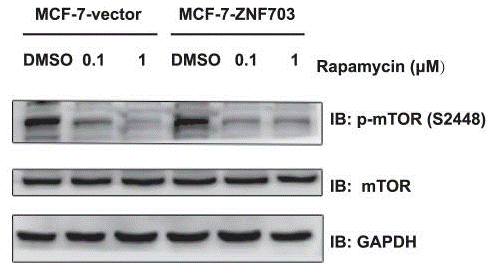
|
23991038 | |
| Growth inhibition assay | Cell proliferation |
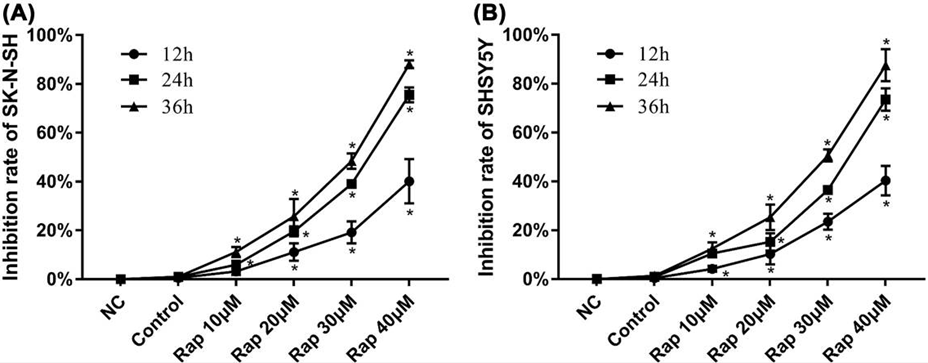
|
30393233 | |
| Histomorphology | Haematoxylin & Eosin |
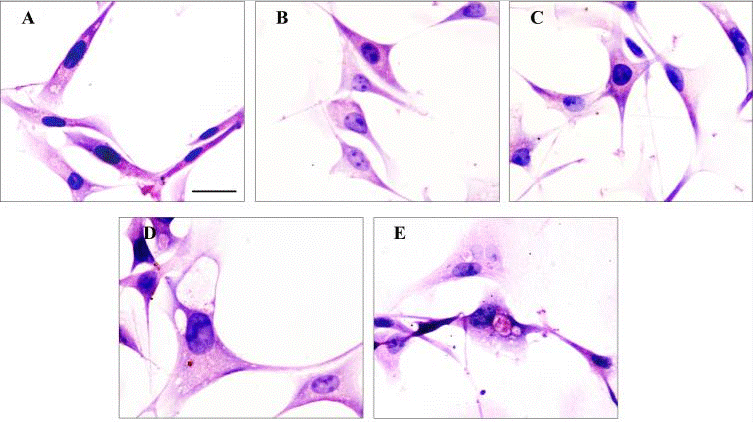
|
28418837 | |
| Immunofluorescence | NeuN p62/Beclin |
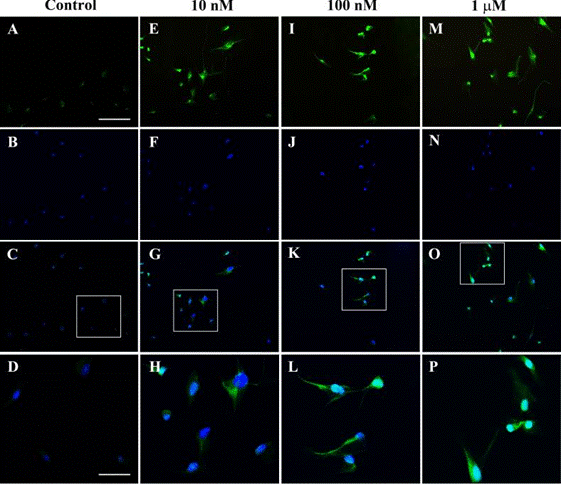
|
28418837 | |
| ELISA | Type III collagen/Fibronectin |
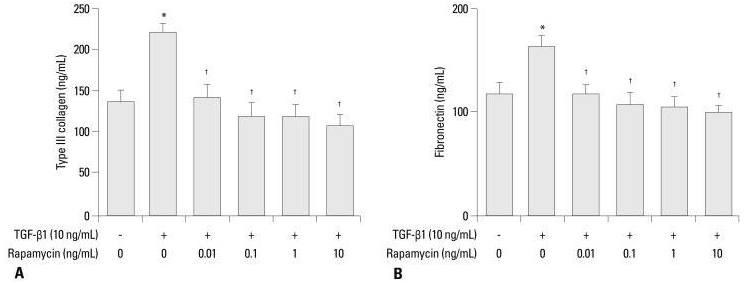
|
23364979 | |
In Vivo |
||
| In vivo | Treatment with Rapamycin in vivo specifically blocks targets known to be downstream of mTOR such as the phosphorylation and activation of p70S6K and the release of inhibition of eIF4E by PHAS-1/4E-BP1, leading to complete blockage of the hypertrophic increases in plantaris muscle weight and fibre size. [4] Short-term treatment with this compound, even at the lowest dose of 0.16 mg/kg, produces profound inhibition of p70S6K activity, which correlates with increased tumor cell death and necrosis of the Eker renal tumors. [5] This chemical inhibits metastatic tumor growth and angiogenesis in CT-26 xenograft models by reducing the production of VEGF and blockage of VEGF-induced endothelial cell signaling. [6] Treatment with this compound at 4 mg/kg/day significantly reduces tumor growth of C6 xenografts, and tumor vascular permeability. [7] |
|
|---|---|---|
| Animal Research | Animal Models | Athymic Nu/Nu mice inoculated subcutaneously with VEGF-A-expressing C6 rat glioma cells |
| Dosages | ~4 mg/kg/day | |
| Administration | Injection i.p. | |
| NCT Number | Recruitment | Conditions | Sponsor/Collaborators | Start Date | Phases |
|---|---|---|---|---|---|
| NCT06308445 | Not yet recruiting | Familial Adenomatous Polyposis |
University Hospital Toulouse |
August 1 2024 | Phase 2 |
| NCT06310291 | Not yet recruiting | Celiac Disease |
Barinthus Biotherapeutics |
April 2024 | Early Phase 1 |
| NCT06091332 | Not yet recruiting | Cavernous Malformations|Brain Stem Hemorrhage |
Huashan Hospital |
December 1 2023 | Phase 2 |
| NCT05997056 | Recruiting | Neuroendocrine Tumors|NET|Pancreatic Neuroendocrine Tumor|Gastrointestinal Neuroendocrine Tumor|Pulmonary Neuroendocrine Tumor |
Aadi Bioscience Inc. |
November 7 2023 | Phase 2 |
| NCT06022068 | Enrolling by invitation | Alzheimer Disease |
Karolinska Institutet|Karolinska University Hospital |
September 1 2023 | Phase 1|Phase 2 |
| NCT04989686 | Recruiting | Immunosuppression |
Children''s Hospital of Philadelphia|Eunice Kennedy Shriver National Institute of Child Health and Human Development (NICHD) |
June 8 2023 | -- |
References |
|
Chemical Information
| Molecular Weight | 914.18 | Formula | C51H79NO13 |
| CAS No. | 53123-88-9 | SDF | Download SDF |
| Synonyms | Sirolimus, AY-22989, NSC-2260804 | ||
| Smiles | CC1CCC2CC(C(=CC=CC=CC(CC(C(=O)C(C(C(=CC(C(=O)CC(OC(=O)C3CCCCN3C(=O)C(=O)C1(O2)O)C(C)CC4CCC(C(C4)OC)O)C)C)O)OC)C)C)C)OC | ||
Storage and Stability
| Storage (From the date of receipt) | |||
|
In vitro |
DMSO : 100 mg/mL ( (109.38 mM) Moisture-absorbing DMSO reduces solubility. Please use fresh DMSO.) Ethanol : 25 mg/mL Water : Insoluble |
Molecular Weight Calculator |
|
In vivo Add solvents to the product individually and in order. |
In vivo Formulation Calculator |
|||||
Preparing Stock Solutions
Molarity Calculator
In vivo Formulation Calculator (Clear solution)
Step 1: Enter information below (Recommended: An additional animal making an allowance for loss during the experiment)
mg/kg
g
μL
Step 2: Enter the in vivo formulation (This is only the calculator, not formulation. Please contact us first if there is no in vivo formulation at the solubility Section.)
% DMSO
%
% Tween 80
% ddH2O
%DMSO
%
Calculation results:
Working concentration: mg/ml;
Method for preparing DMSO master liquid: mg drug pre-dissolved in μL DMSO ( Master liquid concentration mg/mL, Please contact us first if the concentration exceeds the DMSO solubility of the batch of drug. )
Method for preparing in vivo formulation: Take μL DMSO master liquid, next addμL PEG300, mix and clarify, next addμL Tween 80, mix and clarify, next add μL ddH2O, mix and clarify.
Method for preparing in vivo formulation: Take μL DMSO master liquid, next add μL Corn oil, mix and clarify.
Note: 1. Please make sure the liquid is clear before adding the next solvent.
2. Be sure to add the solvent(s) in order. You must ensure that the solution obtained, in the previous addition, is a clear solution before proceeding to add the next solvent. Physical methods such
as vortex, ultrasound or hot water bath can be used to aid dissolving.
Tech Support
Answers to questions you may have can be found in the inhibitor handling instructions. Topics include how to prepare stock solutions, how to store inhibitors, and issues that need special attention for cell-based assays and animal experiments.
Tel: +1-832-582-8158 Ext:3
If you have any other enquiries, please leave a message.
* Indicates a Required Field






































